

Open Innovation, Crowdsourcing, Prize Competitions. 20 Quotes on Discovery. Discover Projects. Niña de 10 años inventa taza involcable para su abuelo con Parkinson. Si la necesidad es la madre de la inventiva, podríamos decir que el amor es su mejor incentivo.
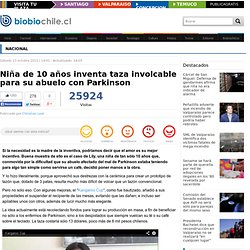
Buena muestra de ello es el caso de Lily, una niña de tan sólo 10 años que, conmovida por la dificultad que su abuelo afectado del mal de Parkinson estaba teniendo para algo tan simple como servirse un café, decidió poner manos a la obra. Y lo hizo literalmente, porque aprovechó sus destrezas con la cerámica para crear un prototipo de tazón que, dotado de 3 patas, resulta mucho más difícil de volcar que un tazón convencional.
Pero no sólo eso. Con algunas mejoras, el “Kangaroo Cup“, como fue bautizado, añadió a sus propiedades el suspender el recipiente de las mesas, evitando que las dañen; e incluso ser apilables unos con otros, además de lucir mucho más elegante. Where do ideas come from? Innovation By Design. Here Are All 56 Finalists In Our 2012 Innovation By Design Awards. Design isn’t the gloss applied at the end of the innovation process.
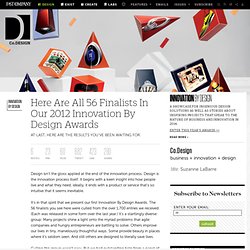
Design is the innovation process itself. It begins with a keen insight into how people live and what they need; ideally, it ends with a product or service that’s so intuitive that it seems inevitable. It’s in that spirit that we present our first Innovation By Design Awards. The 56 finalists you see here were culled from the over 1,700 entries we received. (Each was released in some form over the last year.) Culling this group wasn’t easy. And as you dip into the projects that follow, we hope you’ll be as inspired as we were. Transportation The finalists range from an electric bike by Ideo to the new Ford Fusion. Consumer Products Many of the finalists suggest entirely new sorts of product ecosystems, such as the BioLite CampStove and the Nike+ Fuelband. Innovation: Business, Process & Product Innovation News. The Tao of Innovation. Social Innovation eXchange. Welcome to the Virtual Crash Course in Design Thinking.
Welcome to the d.school’s Virtual Crash Course resource page!
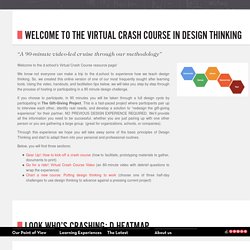
We know not everyone can make a trip to the d.school to experience how we teach design thinking. So, we created this online version of one of our most frequently sought after learning tools. Using the video, handouts, and facilitation tips below, we will take you step by step through the process of hosting or participating in a 90 minute design challenge. If you choose to participate, in 90 minutes you will be taken through a full design cycle by participating in The Gift-Giving Project. This is a fast-paced project where participants pair up to interview each other, identify real needs, and develop a solution to “redesign the gift-giving experience” for their partner.
Through this experience we hope you will take away some of the basic principles of Design Thinking and start to adapt them into your personal and professional routines. WorldAfterMidnight. WAM! Let's Talk Again - WorldAfterMidnight Version2. Eddie Obeng: Smart failure for a fast-changing world. WorldAfterMidnight. Design thinking. Design thinking stands for design-specific cognitive activities that designers apply during the process of designing.[1] Overview[edit] Design thinking has come to be defined as combining empathy for the context of a problem, creativity in the generation of insights and solutions, and rationality in analyzing and fitting various solutions to the problem context.[2] According to Tim Brown, CEO and president of IDEO, the goal of Design Thinking is "matching people’s needs with what is technologically feasible and viable as a business strategy" [3] The premise of teaching Design Thinking is that by knowing about how designers approach problems and the methods which they use to ideate, select and execute solutions, individuals and businesses will be better able to improve their own problem solving processes and take innovation to a higher level.
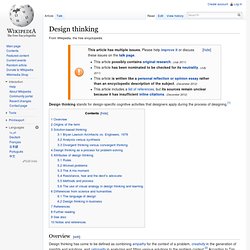
Origins of the term[edit] (For a detailed evolution, see History, below.) Solution-based thinking[edit] Bryan Lawson Architects vs. Steven Johnson: Where good ideas come from. Find A Problem and Create A Solution. The most successful companies solve problems.
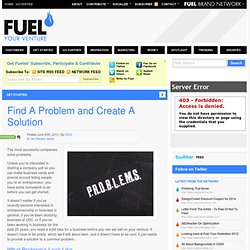
Unless you’re interested in starting a company just so you can make business cards and prance around telling people you’re an entrepreneur, you have some homework to do before you can get started. How to find a problem. These are pieces written to desribe what it is like working in science.
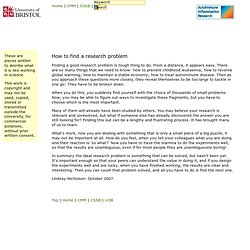
This work is copyright and may not be used, copied, stored or transmitted outside the University, for commercial purposes, without prior written consent. Finding a good research problem is tough thing to do. From a distance, it appears easy. There are so many things that we need to know: how to prevent childhood leukaemia; how to reverse global warming; how to maintain a stable economy; how to treat autoimmune disease. Then as you approach these questions more closely, they reveal themselves to be too large to tackle in one go: They have to be broken down. When you do this, you suddenly find yourself with the choice of thousands of small problems.
Many of them will already have been studied by others. Charles Leadbeater: The era of open innovation. Luis von Ahn: Massive-scale online collaboration.